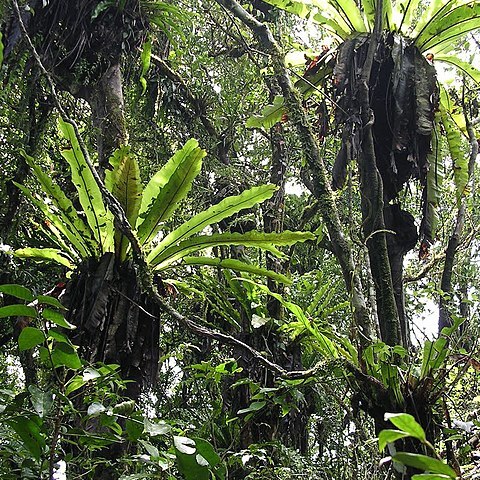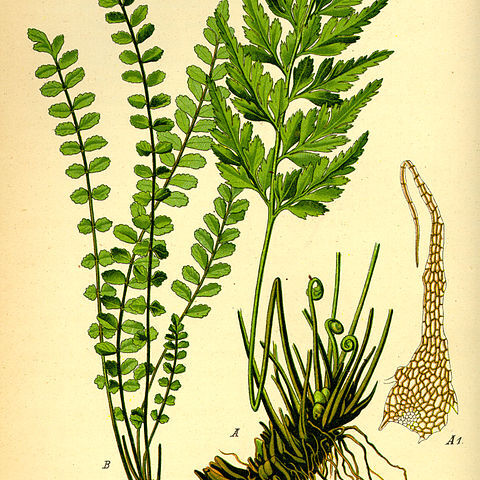Plants small to medium-sized, predominantly epilithic or terrestrial, but also many epiphytic. Rhizome creeping, decumbent, or erect, radial or dorsiventral (Hymenasplenium), sometimes massive and bearing detritus-collecting fronds, scaly; scales narrowly triangular, clathrate with anticlinal walls thickened and periclinal walls translucent, often costate and with a central zone of cells with thicker anticlinal walls, in some taxa becoming completely opaque, rarely whole scale black and opaque, margins entire, dentate, or with short or long outgrowths (fimbriate scales), often with a terminal glandular cell, both surfaces glabrous. Fronds remote (in China mainly in Hymenasplenium) or clustered, spirally arranged or in two abaxial rows (Hymenasplenium), herbaceous or leathery to subfleshy, with scales similar to those on rhizome or gradually reduced in size (mini-scales) and filiform to hastate-stellate, usually with small, 3-or 4-celled uniseriate hairs terminating in a gland, rarely glandular or completely glabrous, occasionally gemmiferous with buds often on, but not restricted to, rachis or at pinna apex; stipe usually distinct, not articulate, rarely forming a trophopod (Asplenium adiantum-nigrum) or persistent (Hymenasplenium), distinctly scaly at base, green to grayish brown, in some species castaneous to black and then often shiny, rounded to grooved (sulcate) adaxially, with two vascular bundles at its base, upward near rachis combined into one X-shaped bundle. Lamina outline variable, from simple to 4-pinnate, apical pinnae usually reduced and confluent into a pinnatifid apex, rarely conform with lateral pinnae (e.g., A. formosae), usually branching anadromously; rachis structure variable, adaxially often sulcate, with or without central supravascular ridge, with or without lateral wings derived from decurrent frond margins, rarely with an abaxial wing (A. tripteropus); pinnae and other divisions often more strongly developed in direction of apex, ultimate pinnules or segments often rhombic, trapeziform, or cuneiform with asymmetrical base, rarely dimidiate, margin rarely entire, more often repand or sinuate to crenate or serrate, each tooth usually with a single vein. Veins mostly free, anadromously branching, veinlets usually not reaching margin, with or without terminal hydathode, rarely anastomosing near margin or with a marginal connecting vein (A. subg. Thamnopteris C. Presl); some species with a dissected lamina have one single vein per ultimate segment. Sori single, rarely "double" on two different veins (A. subg. Phyllitis (Hill) Jermy & Viane), or J-shaped (e.g., A. fontanum), linear to subelliptic, attached along one side of a veinlet, usually indusiate (indusium reduced in A. subg. Ceterach (Willdenow) Vida ex Bir, Fraser-Jenkins & Lovis); indusia thinly membranous to thick and firm, usually flat but occasionally rolling back at maturity, free margin entire to erose, sinuate, fimbriate, glandular, or rarely with mini-scales, attached laterally along a veinlet, opening toward costa, costule, or vein from which soriferous vein originated, in some species with a dissected lamina seemingly opening toward margin (A. prolongatum). Sporangia with a vertical annulus of ca. 20 thickened cells, stalk uniseriate, not glandular. Spores usually 64 per sporangium, bilateral, elliptic to reniform, monolete; exospore smooth, perispores elaborate and very variable, consisting of three layers, outer with ridges (lophate), spines (echinate), or with large pori (reticulate) and no ridges or spines, or a combination. Plants sexual or agamosporous and then often with only 32 spores per sporangium, x = (35)36 in Asplenium, but (36, 38)39 in Hymenasplenium.
More
Plants terrestrial, on rock, or rarely epiphytic. Stems erect or nearly erect, rarely long-creeping, scaly. Steles radially symmetric or dorsiventral (with structurally distinct abaxial and adaxial aspects) dictyosteles. Leaves monomorphic, rarely almost dimorphic with fertile leaves taller and more erect than sterile ones. Petioles with 1 vascular bundle X-shaped in cross section or with 2 vascular bundles back to back and C-shaped. Blades extremely diverse, simple to 4-pinnate, commonly with tiny glandular hairs and a few linear scales, rarely with spreading hairs. Veins free to anastomosing. Sori borne on veins, ± lunate to linear. Indusia usually present, shape conforming to sorus and originating along 1 side of sorus. Sporangia with stalk of 1 row of cells, annulus vertical, interrupted by sporangial stalk. Spores monolete; perispore typically winged, spiny, reticulate, or perforate. Gametophytes surficial, green, cordate.
Terrestrial, lithophytic or epiphytic ferns. Rhizome erect to long-creeping, with a dictyostele. Fronds simple to 1–5-pinnate, monomorphic or rarely dimorphic, membranous, herbaceous or thick and fleshy; stipe usually with two C-shaped vascular bundles, one a mirror image of the other, joining into an X-shaped bundle toward the lamina; venation free or anastomosing without free included veinlets. Clathrate scales present on rhizomes and usually fronds, sometimes also with hairs. Sori on abaxial surfaces, elongated along veins, protected by an elongated indusium or rarely without an indusium, remote or close to and parallel to margins. Spores monomorphic, monolete, spherical or elliptic to reinform, lacking chlorophyll; perispore winged, cristate, reticulate or echinate (not in Australia), with smooth, fenestrate or reticulate areoles; annulus vertical.
Epiphytic or terrestrial; rhizomes creeping or erect; scales clathrate, usually dark


